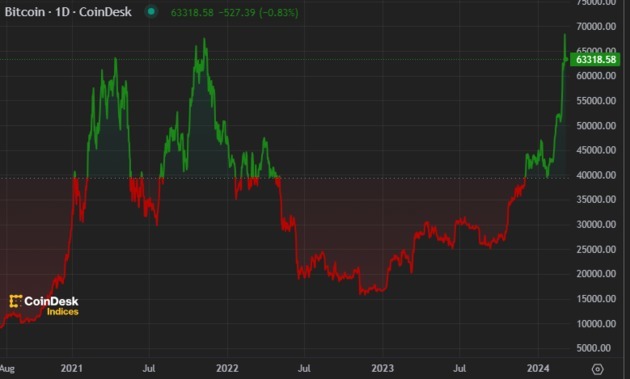On the evening of March 5 (Tuesday), Beijing time, the price of bitcoin (BTC) briefly surpassed $69,000 per coin, setting a new historical high. However, in the following few hours, the price of bitcoin fell below $60,000.
As of the morning of March 6 (Wednesday), Beijing time, the price of bitcoin had fallen nearly $10,000 from its historical peak, dropping by as much as 10%. This crazy price fluctuation triggered a major leveraged liquidation wave, according to CoinGlass data, which showed that more than $810 million worth of leveraged derivative positions involving all cryptocurrencies were liquidated in the past 24 hours.

Photo/ Coindesk
Kevin, the founder of Web3 CD, told NBD that this rally occurred before the “halving”, and it might take a different path. At the same time, he said that this round of bitcoin price increase was driven entirely by the US asset management giants, so it can be said that it was “purely an institutional carnival”, and it hardly gave any trading opportunities to retail investors.
Different from the past, this rally occurred before the “halving”
On the evening of March 5 (Tuesday), Beijing time, the price of bitcoin (BTC) briefly surpassed $69,000 per coin, setting a new historical high. The previous record high was around $69,000 in November 2021. However, in the following few hours, the price of bitcoin plummeted. As of press time, the price of bitcoin was about $63,000 per coin.
The bitcoin genesis block was mined by Satoshi Nakamoto on a small server in Helsinki, Finland, on January 3, 2009. On May 18, 2010, in a transaction where Laszlo Hanyecz, a programmer in Florida, bought pizza, bitcoin was priced by the market for the first time. The initial transaction price was about $0.003, and he spent 10,000 bitcoins to buy two pizzas, worth about $30. Based on the historical high of $69,000, bitcoin has gradually appreciated more than 23 million times since its first pricing.
NBD noted that bitcoin will usher in a new round of “halving” next month (April 2024). Historically, “halving” is an important factor in driving up the price of bitcoin.
“Halving” refers to the halving of the reward for producing a new block, which occurs about every four years, depending on the speed of block generation on the bitcoin network. This will reduce the supply of bitcoin, and it is expected that on April 23, 2024, the block reward will be reduced from 6.25 (BTC) to 3.125 (BTC).
Regarding the upcoming “halving”, Kevin, the founder of Web3 CD told NBD that “the previous cryptocurrency bull markets were all after the ‘halving’, but this time it was before the halving. So this round of market may take a different way from the previous ones. However, at least for now, the cryptocurrency market as a whole is still in a relatively disorderly state, and no one can better predict the next trend.”
In less than two months, $7.4 billion of funds have flowed into bitcoin ETFs
The listing of bitcoin spot ETFs also boosted the price of bitcoin to some extent earlier this year. On January 11, 2024, the SEC officially approved the applications of 11 bitcoin spot ETFs, including BlackRock and other institutions. CITIC Securities pointed out that the SEC’s approval of bitcoin ETFs has standardized the trading of cryptocurrencies to some extent, and the cryptocurrency market, which used to be dominated by retail investors, will undergo some changes, and more liquidity is expected to bring short-term prosperity to cryptocurrencies in the first half of 2024.
At present, the asset management scale of these 11 bitcoin spot ETFs has exceeded $16 billion. If the Grayscale Bitcoin Trust (GBTC), which has been converted into an ETF, is included, the total asset management scale of bitcoin ETFs exceeds $40 billion.
Data shows that in February this year, $5.9 billion of funds flowed into bitcoin ETFs. From January 11 to the end of February, the fund inflow of bitcoin ETFs was $7.4 billion, while the outflow of gold ETFs was $2.9 billion in the same period. The market speculated that some market investors chose to sell gold ETFs and buy bitcoin ETFs.
According to data from the London Stock Exchange Group, in the week ending March 1, the net amount of funds flowing into the top 10 US spot bitcoin funds reached $2.17 billion, more than half of which flowed into the iShares Bitcoin Trust Fund of BlackRock in the United States.
Although the listing of these ETFs provided convenience for ordinary investors to trade bitcoin, Kevin told NBD that this round of bitcoin bull market was “purely an institutional carnival”.
He told NBD, “The rise of bitcoin in this round was driven entirely by these US asset management giants, such as BlackRock, Ark, and so on. In this round of market, many ordinary retail investors did not have positions, and under the carnival of institutions, they hardly gave any opportunities for retail investors to participate.”
“Although in the long run, the market value of bitcoin will surpass that of gold, and people’s acceptance of bitcoin will become wider and wider in the future, the risk (of the entire cryptocurrency market) lies in its volatile nature. After seeing bitcoin set a new historical high, retail investors may continue to enter this market. When institutions distribute chips, and retail investors may become ‘suckers’. So for ordinary investors, cryptocurrency is a high-risk market.” Kevin added.
It is worth mentioning that SEC Chairman Gary Gensler also emphasized earlier that although the SEC approved the listing and trading of some bitcoin spot ETFs, it did not approve or endorse bitcoin. Bitcoin is a speculative and highly volatile asset, and investors should be cautious about the risks of bitcoin and products linked to the value of cryptocurrencies.
Disclaimer: The content and data of this article are for reference only and do not constitute investment advice. Verify before using.


 川公网安备 51019002001991号
川公网安备 51019002001991号





